As you know, Cx Associates’ work focuses on making buildings perform better for occupants, operators, owners, and for the planet. A common metric we use to assess building performance is the energy use intensity (EUI) which Katie has discussed in her recent blog posts. While attending the recent IEPEC Conference in Denver, I had a discussion with someone familiar with Xcel Energy’s work to be a net zero carbon utility in the relatively near future. We realized that EUI is an insufficient metric for guiding energy program investments at their customer sites. Ultimately, to drive carbon emissions down to a sustainable level that will halt and begin to reverse the climate crisis we are currently in, we need to track energy intensity while also focusing on carbon emissions intensity (CEI) at a building level. Cities and states that have adopted carbon reduction goals will do well to focus on reducing the CEI of their building stock through energy efficiency, fuel switching, and renewable energy generation.
3 min read
A New Metric for 21st Century Buildings: The Carbon Emissions Intensity (CEI)
By Jennifer Chiodo on Sep 25, 2019 10:00:00 AM
Topics: Sustainability Green Building Energy Efficiency Building Performance & Technology renewable Energy Management Existing Building portfolio benchmarking Program Consulting Energy Planning energy monitoring & solutions Energy Audit energy efficiency program M&V
3 min read
Benchmarking and Beyond
By Katie Mason on Aug 23, 2019 10:00:00 AM
In a previous blog post, I discussed the energy benchmarking service we currently perform for a healthcare network using the Energy Star Portfolio Manager (ESPM) tool. This tool is used to monitor the energy usage of a building over time. It allows a user to set energy goals, compare the overall energy use intensity (EUI) to a baseline year, and compare the building in question to other buildings with similar use-types and characteristics. In addition to continuing this specific service for the healthcare network, Cx Associates uses the benefits of benchmarking in other areas of our work too. This blog post will discuss what other areas of our work utilize benchmarking and then provide a brief update on changes ESPM has made to their scoring metrics over the past year.
Topics: Standards and Metrics Energy Efficiency Building Performance & Technology retrocommissioning Energy Management Existing Building portfolio benchmarking Energy Planning energy monitoring & solutions Energy Audit Building M&V
3 min read
Occupant Based Controls for Energy Savings
By Daniel Tuhus-Dubrow on Jul 3, 2019 10:00:00 AM
I recently attended the Performance Evaluation Methodology for Building Occupancy Sensing Systems for HVAC Controls workshop, which followed the annual ASHRAE conference that just wrapped up in Kansas City, MO. The workshop focused on one of ARPA-E’s[1] research programs called SENSOR (Saving Energy Nationwide in Structures with Occupancy Recognition)[2], and brought together a diverse group of individuals, including researchers from national labs and universities, industry representatives, design engineers, and other interested parties.
Topics: Standards and Metrics Building Performance & Technology HVAC New Construction Existing Building Controls upgrade Efficiency Program Program Evaluation energy efficiency program M&V
3 min read
Retrocommissioning 2.0
By Jennifer Chiodo on Feb 6, 2019 12:30:00 PM
Retrocommissioning (RCx) or Existing Building Commissioning refer to a technical process that retrofits and tunes building HVAC control systems so that buildings function more efficiently and effectively. The RCx process has historically included three primary phases: Planning, Investigation, and Implementation.
Topics: Energy Efficiency Building Performance & Technology retrocommissioning Energy Management Existing Building
4 min read
Retrocommissioning - Looking Back to Move Forward
By Tate Colbert on Nov 28, 2018 12:00:00 PM
As the newest engineer to join the Cx Associates team, I have had the immense pleasure to be able to approach buildings from a different angle than in my previous work experience. In my former work as a mechanical design engineer, the focus was on current building technologies and keeping up with the most cutting-edge designs for our systems and buildings. Don’t get me wrong, looking to the future of efficient building technologies is tremendously important, but as someone who is concerned about the current state of the environment and ensuring there’s a habitable world for generations of living things to come, I found it hard to believe that new buildings alone are capable of being more than a small drop in a big bucket. After all, there are only a small number of new buildings built each year compared to the vast existing building stock. A quick look at the numbers from the Commercial Buildings Energy Consumption Survey (CBECS) by the US Energy Information Administration (EIA) will tell you that of the total data set, only about 18% of commercial buildings were built in the most recent 12 years surveyed. (https://www.eia.gov/consumption/commercial/data/2012/bc/cfm/b8.php)
Topics: Energy Efficiency Building Performance & Technology retrocommissioning Energy Management Existing Building
4 min read
The Unique Needs of Operating Room Upgrades: A Project Manager's Perspective
By Katie Mason on Oct 17, 2018 12:00:00 PM
Space upgrades are necessary to ensure that older buildings remain safe, functional, and cutting-edge for the users. As part of my role as an owner’s project manager for a large hospital, one of my recent projects has been upgrading the finishes of several operating rooms. This post discusses the coordination and construction effort involved for such a project, as well as some potential challenges.






